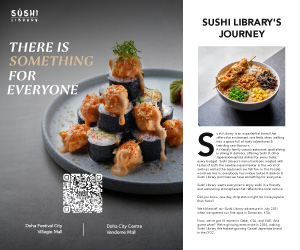Speak the Language

The term ‘love languages’ comes from the book The Five Love Languages: How to Express Heartfelt Commitment to Your Mate by Gary Chapman, first published in 1992. These five languages of love are five different ways of expressing and receiving love: words of affirmation, quality time, receiving gifts, acts of service, and physical touch. Here, we dive deep into each language and show you the little things you can do to make your relationship stronger. And remember — this isn’t about your love language, it’s about your partner’s.
Words of Affirmation

Words speak louder than actions for those whose love language is highly concentrated in this section. These people love spontaneous compliments and pet names, and cherish the simple three words “I love you” more than most – even more if they’re told the reasons why they’re loved.
If you or your loved one fall in this category, then kind words mean the world to you or them. Getting a compliment automatically boosts their day and giving appreciation for all they do will fall like rain on parched soil. Before long, you’ll see the seeds of your love sprouting up in your relationship as your better half responds with positivity. This includes compliments, words of appreciation, and verbal encouragement. A concept in psychology suggests that using affirmative words increases our brain functions, resulting in an increase in cognitive reasoning and strengthened frontal lobes. But be wary; hateful comments make just as big of an impact – or even more – as loving statements.
Now, this doesn’t mean that you constantly need to express your love, reinforce your appreciation, or praise them like a child for washing their hands or brushing their teeth. Instead, your words need to be meaningful and used in situations where work was done, or when you feel they need a little pick-me-up. This love language doesn’t require you to go out of your way – just a little attention.

These words of affirmation are not to boost their pride. Trust us, these words do not go to their head. It’s not even about using flattery to win the other person over. “The object of love is not getting something you want, but doing something for the wellbeing of the one you love,” notes Chapman in his book. This love language builds up the confidence of your partner and lets them know that their actions and presence do not go unnoticed. Here are some simple ways and tips on how to be fluent in this language.
Be Authentic and Empathetic
You don’t need to be a poet or wordsmith to master this language. Your partner chose you for you, not only your ability to express your emotions through words. We suggest being yourself. Be witty, be funny, be romantic – it’s up to you. All you need to be sure about is speaking from the heart. Love is not one size fits all, so do what you can and see what they respond to. This also brings us to recognising your partner’s emotions. Think about what it would be like to walk in their shoes and show them that you empathise with them through your words, no matter how big or small the situation.

Post a Note/Letter
There’s something special about hand-written words – they add a touch of romance. Place Post-it notes on the bathroom mirror, send them a sweet message out of the blue, or write them a silly poem. For even more romance in your life, extend that Post-it into a letter (no, not an e-mail). This can be a great way to commemorate special occasions and will create a memento to help remember the day forever. ✤
Physical Touch

Not only are people of this love language happy when they see you around, but they also need physical confirmation that you’re there. It is the non-verbal love language that focuses more on physical intimacy.
Touch is one of the strongest and earliest sensory languages, and one that we’re introduced to immediately upon birth. As an infant, we understand who our mother is and her love just by the warmth of her skin. A baby, when crying or bothered, will seek its mother’s touch – and we’re not much different as adults. “When you reach out with tender touch, you create emotional closeness,” says Chapman in his book.
Physical touch doesn’t have to be very intimate, and there is way more to the notion of physical touch than what we think. Expressions of physical touch don’t necessarily have to lead to intimacy. It can be as simple as a hand squeeze when your partner is anxious, a brush on the arm as you pass by, or just holding hands while walking around a supermarket. It can even be sitting side by side with your arms touching. For those who understand physical touch, this sounds like a no-brainer, but if you don’t, doing this unconsciously is hard.

Basically, having touch as a love language means that all physical gestures matter more than gifts or saying, “I love you.” This person can be taken on the most extravagant date, but still only feel butterflies when cuddled up in bed together. Your constant physical contact assures them that you are there, you are present, and they are cherished. And that is enough. Here are some simple ways and tips on how to be fluent in this language.
Non-Intimate Touch
Despite what you may have learnt through movies or past experiences, there are different levels of intimacy – and intimacy isn’t everything. Learn what touch makes your partner feel most loved and remember, what works for you may not work for them. A hug or kiss seems to be the universal act of love, but everyone still has their preferences. For some, it’s as simple as a touch on the shoulder.

PDA Level
Even if your significant other basks in this love language, remember to make sure that it’s comfortable for both of you. If you’re not the touchy-feely or PDA type, then meet in the middle when you’re out on the town. Give their hand an affectionate squeeze if you’re not comfortable holding it throughout in public or sit on the same side of the table if you’re dining out. But remember that it’s a two way street – you need to be mindful of their love language and they should be mindful of yours. ✤
Receiving Gifts

This language has a bad reputation for being materialistic, but it’s more heartfelt than you might think. It’s more about the thought behind the present – which is symbolic of love and affection – than its value.
Of all the love languages, the act of receiving gifts is undoubtedly the most misunderstood. While gift giving in most circumstances is known to be more materialistic, it’s more symbolic as a love language. In his book, Chapman observes: “From early years, children are inclined to give gifts to their parents, which may be another indication that gift-giving is fundamental to love. Gifts are visual symbols of love.”

Take a walk down memory lane to a time when you would hide in your room making birthday cards and macaroni necklaces for your parents – it was your way of showing them that you cared. And even though those handmade cards and gifts would be worth next to nothing in monetary value, they were still proudly displayed around the house, symbolising just how important you and your gesture were. This is further emphasised by Chapman as he refers to such gifts as “visual symbols of love”.
Gift-giving is present in almost every culture in the world, especially in the love-then-marriage process, the most familiar symbols being the exchange of rings between a bride and groom. You will notice how many couples place a lot of importance on these rings, never taking them off. This is not because of their monetary value, but the meaning they carry. Here are some simple ways and tips on how to be fluent in this language.

More than Materialism
At a time when many of us are trying to practice minimalism and disregarding objects that don’t ‘bring us joy’, the notion of receiving gifts can be thought of as materialistic and unnecessary.
Cynics also label this as ‘buying’ love. However, this couldn’t be further from the truth. This love places the intangible aspects of gift-giving higher than the tangible ones. It’s not only about the action, but also the process. It shows a person that their partner is thinking about them and made the effort to show it. The monetary value of the present is rarely an issue; even a bar of their favourite chocolate or a single flower can be enough to make their day. After all, it’s the intention behind the gesture that matters.

Mark Your Calendar
The people high in this love language tend to take birthdays and anniversaries seriously, which might put some pressure on partners who do not share the same celebratory ideals. However, these are prime gift-giving occasions that shouldn’t be missed. A word to the wise: setting reminders on the calendar in your phone can go a long way in case you tend to forget momentous dates. ✤
Quality Time

Attention, attention, attention – the only thing these people need is your time, whether at home or out in the real world. Hint: forget that your phone or jobs exists when you’re with them.
This expression of love has an emphasis on quality over quantity, revolving around togetherness without any interference from external factors. We suggest that you put down your phone, turn off the TV, and focus on them when you’re with your partner. Chapman explains, “Quality time is giving someone your undivided attention. I don’t mean sitting on the couch watching television. I mean sitting on the couch with the TV off, looking at each other and talking.”
Of course, couples spend time together, but it’s the quality of time that matters to this group – no distractions, no other people, just you two. People in this group strive for focused attention. It’s not enough being in the same vicinity; they need you to give them your eyes and ears with full attentiveness. Quality time for someone with this love language means taking time to go on walks with one another, speak to one another, and just be there. Sounds simple, doesn’t it? Well, not for everyone.

The other languages, when assessed properly, are easy to figure out. And once you and your partner understand what each of you need – be it gifts or words of affirmation – it’s just about following through with the action. And quality time proves to be more tricky than most, just because it is literally that – time. And lots of it. The world is moving faster and our lives are engulfed in work, home chores, and social or family obligations, making the simplest act the hardest. Here are some simple ways and tips on how to be fluent in this language.
Beginning and Endings
Make it a habit to begin and end your day together. Start your day off by making and eating breakfast before work, meditating, or just chatting for a couple of minutes in bed. The same can be done at the end of the day. Turn off all your devices and let the stress of the day flow out in conversation. Chapman suggests, “After work, set aside 10 minutes to catch up – no phones allowed.” This way, you’ll be able to connect with your partner on a daily basis, making them feel fulfilled and appreciated. Now, not all routines will be able to allow this, but even the slightest effort to spend time with them will not go unnoticed.

Be Present
By now, we all know that technology is a big no-no when it comes to people whose primary love language is quality time. They know that time is always limited, and tomorrow isn’t guaranteed, therefore they see the concept of time as a priceless gift that needs to be cherished. Be present and interested in what they have to say, ask questions, ask follow-up questions, and let them know that you will prioritise them over everyone and everything else. ✤
Acts of Service

They say actions speak louder than words and, for some people, that is particularly true when showing acts of love. It’s the non-verbal form of love that can be time-consuming, but if it’s what your partner needs, then that’s what they shall receive.
Ask your spouse which of these three scenarios would fill their heart with love and joy if they were to come home after a weekend away:
A. You immediately tell them that they were missed
B. The house is clean and there’s a warm meal on the table
C. You jump and embrace them in a big, squishy hug
We’re pretty sure they’ll appreciate all of the above, but if they chose option B, then acts of service is likely their love language. For this demographic, saying “I love you” doesn’t guarantee that the speaker means it – they need to see actions to believe it. But don’t worry, this doesn’t mean that your partner is lazy and wants you to do all the heavy lifting. In fact, they’re most likely self sufficient and super motivated. This is actually why acts of service is their love language.

They simply want you to step in a little to help and lighten their burden – to them, that is real love. It’s not about the deed itself, but working together to attain a goal. It’s important to note that acts of service aren’t about helping around the house or becoming a butler to your significant other. You need to work with them, not for them. It’s about creating an equal partnership. “Love is something you do for someone else, not something you do for yourself,” adds Chapman. So, make the bed even if they woke up after you or organise their laundry if you know they have a full day ahead. Here are some more simple ways and tips on how to be fluent in this language.

Go Beyond the House
Not every act of service revolves around household chores, which is the biggest misconception around this language. Yes, it’s a labour of love, but the labour doesn’t need to be fatiguing. And sure, everyone appreciates coming back to a clean home and tidy bed, but this language can be as simple as grabbing them a bottle of water when you get one for yourself. Go beyond the daily chores of the house by filling up the car’s gas tank on your way home so they don’t have to in the morning.

Communicate
You don’t need to be a mind reader; simply ask your partner what you can do to make their day a little easier. If you see they’re working late, ask them if they’d like to sleep in the next morning while you take the dog for a walk instead. According to Chapman, people who prefer acts of service appreciate nothing more than hearing, “Let me do that for you.” It’s the thought behind the action that counts – the action just affirms it. ✤





















